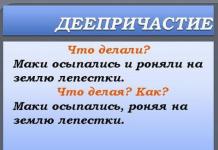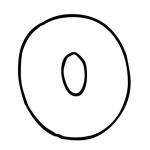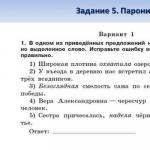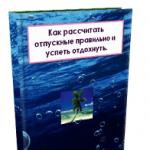Basicsmolecular physics and thermodynamics
Statistical and thermodynamic research methods. Molecular physics and thermodynamics are branches of physics in which they study macroscopic
processes in bodies, associated with the huge number of atoms and molecules contained in the bodies. To study these processes, two qualitatively different and mutually complementary methods are used: statistical (molecular kinetic) and thermodynamic. The first underlies molecular physics, the second - thermodynamics.
Molecular physics - a branch of physics that studies the structure and properties of matter based on molecular kinetic concepts, based on the fact that all bodies consist of molecules in continuous chaotic motion.
The idea of the atomic structure of matter was expressed by the ancient Greek philosopher Democritus (460-370 BC). Atomism was revived again only in the 17th century. and is developed in the works of M.V. Lomonosov, whose views on the structure of matter and thermal phenomena were close to modern ones. The rigorous development of molecular theory dates back to the middle of the 19th century. and is associated with the works of the German physicist R. Clausius (1822-1888), the English physicist J. Maxwell (1831 - 1879) and the Austrian physicist L. Boltzmann (1844-1906).
The processes studied by molecular physics are the result of the combined action of a huge number of molecules. The laws of behavior of a huge number of molecules, being statistical laws, are studied using statistical method. This method is based on
that the properties of a macroscopic system are ultimately determined by the properties of the particles of the system, the features of their movement and averaged values of the dynamic characteristics of these particles (speed, energy, etc.). For example, the temperature of a body is determined by the speed of the random movement of its molecules, but since at any moment of time different molecules have different speeds, it can only be expressed through the average value of the speed of movement of the molecules. You can't talk about the temperature of one molecule. Thus, the macroscopic characteristics of bodies have a physical meaning only in the case of a large number of molecules.
Thermodynamics- a branch of physics that studies the general properties of macroscopic systems in a state of thermodynamic equilibrium and the processes of transition between these states. Thermodynamics does not consider the microprocesses that underlie these transformations. This thermodynamic method different from statistical. Thermodynamics is based on two principles - fundamental laws established as a result of generalization of experimental data.
The scope of application of thermodynamics is much wider than that of molecular kinetic theory, since there are no areas of physics and chemistry in which the thermodynamic method cannot be used. However, on the other hand, the thermodynamic method is somewhat limited: thermodynamics does not say anything about the microscopic structure of matter, the mechanism of phenomena, but only establishes connections between macroscopic
properties of the substance. Molecular kinetic theory and thermodynamics complement each other, forming a single whole, but differing in various research methods.
Thermodynamics deals with thermodynamic system- a set of macroscopic bodies that interact and exchange energy both among themselves and with other bodies (the external environment). The basis of the thermodynamic method is determining the state of a thermodynamic system. The system state is set thermodynamic parameters (state parameters) - a set of physical quantities that characterize the properties of a thermodynamic system. Typically, temperature, pressure and specific volume are chosen as state parameters.
Temperature is one of the basic concepts that plays an important role not only in thermodynamics, but also in physics in general. Temperature- a physical quantity characterizing the state of thermodynamic equilibrium of a macroscopic system. In accordance with the decision of the XI General Conference on Weights and Measures (1960), only two temperature scales can currently be used - thermodynamic and international practical, graduated respectively in Kelvin (K) and degrees Celsius (°C).
In the International Practical Scale freezing and boiling temperatures of water at a pressure of 1.013 10 5 Pa, respectively, 0 and 100 ° C (the so-called reference points).
Thermodynamic temperature scale is determined by one reference point, which is taken as triple point of water(the temperature at which ice, water and saturated steam at a pressure of 609 Pa are in thermodynamic equilibrium). The temperature of this point on the thermodynamic scale is 273.16 K (exact). Degree Celsius is equal to Kelvin. On the thermodynamic scale, the freezing point of water is 273.15 K (at the same pressure as on the International Practical Scale), therefore, by definition, thermodynamic temperature and temperature on the International Practical Scale are related by the ratio T = 273.15 + t. Temperature T=0 is called zero kelvin. Analysis of various processes shows that 0 K is unattainable, although approaching it as close as desired is possible.
Specific volumev is the volume per unit mass. When the body is homogeneous, i.e. its density =const, then v=V/m= 1/. Since at constant mass the specific volume is proportional to the total volume, the macroscopic properties of a homogeneous body can be characterized by the volume of the body.
System status settings may change. Any change in a thermodynamic system associated with a change in at least one of its thermodynamic parameters is called thermodynamic process. The macroscopic system is in thermodynamic equilibrium, if its state does not change over time (it is assumed that the external conditions of the system under consideration do not change).
Chapter 8
Molecular kinetic theory of ideal gases
§ 41. Experimental laws of ideal gas
In molecular kinetic theory they use idealized modelideal gas, according to which:
1) the intrinsic volume of gas molecules is negligible compared to the volume of the container;
2) there are no interaction forces between gas molecules;
3) collisions of gas molecules with each other and with the walls of the vessel are absolutely elastic.
The ideal gas model can be used in the study of real gases, since under conditions close to normal
small (for example, oxygen and helium), as well as at low pressures and high temperatures, are close in their properties to an ideal gas. In addition, by making corrections that take into account the intrinsic volume of gas molecules and the acting molecular forces, one can move on to the theory of real gases.
Experimentally, even before the advent of the molecular kinetic theory, a whole series of laws were established that describe the behavior of ideal gases, which we will consider.
LawBoyle - Mariotta : for a given mass of gas at a constant temperature, the product of the gas pressure and its volume is a constant value:
pV = const(41.1) at T= const, m=const.
Curve depicting the relationship between quantities R And V, characterizing the properties of a substance at a constant temperature is called isotherm. Isotherms are hyperbolas located on the graph, the higher the temperature at which the process occurs (Fig. 60).
LawGay Lussac : 1) the volume of a given mass of gas at constant pressure changes linearly with temperature:
V=V 0 ( 1+ t)(41.2) at p= const, m= const;

2) the pressure of a given mass of gas at a constant volume changes linearly with temperature:
p = p 0 ( 1+ t)(41.3) at V=const, m=const.
In these equations t- temperature on the Celsius scale, R 0 And V 0 - pressure and volume at 0°C, coefficient =1/273.15 K -1.
Process, flowing at constant pressure is called isobaric. On the diagram in coordinates V,t(Fig. 61) this process is depicted by a straight line called isobar. Process, flowing at a constant volume is called isochoric. On the diagram in coordinates R,t(Fig. 62) it is depicted by a straight line called isochore.
From (41.2) and (41.3) it follows that isobars and isochores intersect the temperature axis at the point t=-1/=-273.15 °C, determined from the condition 1+t=0. If you shift the origin to this point, then the transition to the Kelvin scale occurs (Fig. 62), from where
T=t+ 1/ .

By introducing thermodynamic temperature into formulas (41.2) and (41.3), the Gay-Lussac laws can be given a more convenient form:
V=V 0 (1+ t)=V 0 = v 0 t,
p=p 0 (1+ t)=p 0 =p 0 T, or
V 1 /V 2 = T 1 /T 2 (41.4)
with p = const, m = const,
R 1 /R 2 = T 1 /T 2 (41.5) at V=const, m=const,
where indices 1 and 2 refer to arbitrary states lying on the same isobar or isochore.
LawAvogadro : moles of any gases at the same temperature and pressure occupy the same volumes. Under normal conditions, this volume is 22.41 10 -3 m 3 /mol.
By definition, one mole of different substances contains the same number of molecules, called Avogadro's constant:
n a = 6.022 10 23 mol -1.
LawDalton : the pressure of a mixture of ideal gases is equal to the sum of the partial pressures of the gases entering it, i.e.
p=p 1 +p 2 +... +p n ,
Where p 1 ,p 2 , ..., p n- partial pressures- the pressure that the gases of the mixture would exert if they alone occupied a volume equal to the volume of the mixture at the same temperature.
Molecules in an ideal gas move chaotically. The movement of one molecule is characterized by microscopic parameters (the mass of the molecule, its speed, momentum, kinetic energy). The properties of a gas as a whole are described using macroscopic parameters (gas mass, pressure, volume, temperature). Molecular kinetic theory establishes the relationship between microscopic and macroscopic parameters.
The number of molecules in an ideal gas is so large that the patterns of their behavior can only be determined using a statistical method. The uniform distribution of ideal gas molecules in space is the most probable state of the gas, i.e., the most common.
The distribution of ideal gas molecules by speed at a certain temperature is a statistical pattern.
The most probable speed of molecules is the speed possessed by the maximum number of molecules. A stationary equilibrium state of a gas is a state in which the number of molecules in a given velocity range remains constant.
Body temperature is a measure of the average kinetic energy of the translational motion of its molecules:
where the bar above is the sign of averaging over velocities, k = 1.38 10 -23 J/K is Boltzmann’s constant.
Thermodynamic temperature unit- kelvin (K).
At absolute zero temperature, the average kinetic energy of molecules is zero.
Root mean square (thermal) speed of gas molecules

where M is the molar mass, R = 8.31 J/(K mol) is the molar gas constant.
Gas pressure- a consequence of impacts of moving molecules:

where n is the concentration of molecules (the number of molecules per unit volume), E k is the average kinetic energy of a molecule.
The pressure of a gas is proportional to its temperature:

Loschmidt's constant- ideal gas concentration under normal conditions (atmospheric pressure p = 1.01 10 5 Pa and temperature T = 273 K):
Clapeyron-Mendeleev equation- equation of state of an ideal gas, connecting three macroscopic parameters (pressure, volume, temperature) of a given mass of gas.

Isoprocess- a process in which one of the macroscopic parameters of the state of a given mass of gas remains constant. An isothermal process is a process of changing the state of a certain mass of gas at a constant temperature.
Boyle-Mariotte Law: for a gas of a given mass at constant temperature:

where p 1, p 2, V 1, V 2 - pressure and volume of gas in the initial and final states
Isotherm- graph of changes in macroscopic gas parameters during an isothermal process. An isobaric process is a process of changing the state of a certain mass of gas at constant pressure.
Gay-Lussac's Law: for a gas of a given mass at constant pressure
Size: px
Start showing from the page:
Transcript
1 48 Lecture 8. The equation of state of an ideal gas and the basic equation of MKT chapter 8, 4-4 Lecture plan. Basic provisions and basic concepts of MKT.. Equation of state of an ideal gas. Experimental gas laws.. Basic equation of MKT for ideal gases.. Basic provisions and basic concepts of MKT. There are two main methods for describing physical phenomena and constructing corresponding theories:) molecular-kinetic (statistical);) thermodynamic. The molecular kinetic method considers the properties of physical objects as the total result of the action of all molecules. The behavior of an individual molecule is analyzed based on the laws of classical mechanics, and the results obtained are extended to a population of large numbers of molecules using a statistical method using the laws of probability theory. This is possible because the movement of each molecule, although it follows the laws of classical mechanics, is random, because molecular speeds obey the laws of probability theory. The more particles there are in the system, the better the agreement between the conclusions of statistical theory and the experimental results. The advantage of the method is a clear picture of the mechanism of the phenomenon under consideration. Disadvantage - the conclusions of the MC theory are the result of averaging, therefore they are approximate. The thermodynamic method is based on the introduction of the concept of energy and considers all processes from an energy point of view, based on the laws of conservation and transformation of energy from one type to another. Molecular physics is a branch of physics that studies the structure and properties of matter based on molecular kinetic theory. The idea of the atomic structure of matter was expressed by the ancient Greek philosopher Democritus (4 BC). As a scientific hypothesis, the theory of atomism is revived in the 12th century and developed in the works of Lomonosov (8th century), who explained thermal phenomena as a result of the movement of the smallest particles of matter. The main provisions of MCT are based on a number of experimental data and observations (diffusion, Brownian motion).. All substances consist of atoms or molecules.. Atoms of all substances are in constant chaotic motion.. Atoms (or molecules) of all substances interact with each other. Diffusion is the phenomenon of penetration of molecules of one substance between molecules of another when they come into contact. Brownian motion is the chaotic movement of particles suspended in a liquid or gas.
2 49 A molecule is the smallest particle of a substance that has all its chemical properties. 6 kg, d m. Molecular mass - the mass of one molecule, measured in amu. Let us introduce the concept of a mole of a substance. substance mass m-ly (amu) mass of substance (g) number of molecules H 6, C 6, O 6, CO, mol - this is the amount of substance that contains as many molecules as there are in g 6 C (SI base unit). Avogadro's number A is the number of molecules contained in one mole of any substance. Molar mass is the mass of one mole. kg n, A 6, mol mol, number of moles of a substance, number of molecules of a substance.. Equation of state of an ideal gas. Experimental gas laws. MCT uses an idealized ideal gas model. An ideal gas is a gas whose molecules can be considered as material points, and their interaction has the character of an absolutely elastic impact. (at low p and high T, real gases approach ideal gases). The state of a certain mass of gas is determined by three thermodynamic parameters: p,. Gas pressure is the result of gas molecules hitting the walls of the container in which the gas is located. [p] = pa, = m. In accordance with the decision of the XI General Conference on Weights and Measures (96), two temperature scales are used - thermodynamic (Kelvin) and International Practical (Celsius). The freezing temperature of water at p = atm is taken as C. K is the temperature at which the chaotic movement of molecules should stop. Analysis of various processes shows that K is unattainable, although approaching it as close as desired is possible. A degree Kelvin is equal to a degree Celsius. Т= tс+ 7, t. There is a certain relationship between the gas parameters, called the equation of state. The equation relating the parameters of the state of an ideal gas is called the equation of state of an ideal gas or the Clapeyron equation: const. ()
3 5 For a given mass of an ideal gas, the ratio of the product of pressure and volume to absolute temperature is a constant value. Let us determine the value of the constant for a certain amount of ideal gas, namely for one mole. According to Avogadro's law, a mole of any gas under normal conditions (T = 7 K, p = 5 Pa) has M =.4 - m. For one mole 5. Pa.4 m / mol J 8, ; 7K mol K J R 8, is the molar gas constant. mol K For an arbitrary mass of gas, R, R, R, the Mendeleev-Clapeyron equation is the equation of state of an ideal gas of arbitrary mass. Equation () combines three special cases, three empirical laws for isoprocesses, i.e. processes in which one of the parameters remains constant.. T = const isothermal process, or const - Boyle-Mariotte law: for a given mass of an ideal gas at T = const, the product of pressure and volume is a constant value. Graphs of the dependence between the parameters of the gas state at T=const are presented in Fig... p= const isobaric process, or const - Gay-Lussac's law: for a given mass of an ideal gas at p=const, the volume is directly proportional to the absolute temperature. Rice. Graphs of the dependence between the parameters of the gas state at p=const are presented in Fig... =const is an isochoric process, or const - Charles’s law: for a given mass of an ideal gas at =const give Fig. Rice.
4 5 temperature is directly proportional to absolute temperature. Graphs of the dependence between the parameters of the state of the gas at =const are presented in the figure. The collisions of gas molecules with walls are shown. The average force arising from the combined action of all gas molecules determines the gas pressure. Let's imagine a vessel in the form of a rectangular parallelepiped containing an ideal gas (Fig. 4). Let us calculate the gas pressure on one of the walls of the vessel area. Let us consider the impact of one molecule, which before the impact was moving perpendicular to the wall. According to the law of conservation of momentum Y Z C, C, c t Fig. 4,. Basic MKT equation for ideal gases. The basic MKT equation connects the parameters of the state of a gas with the characteristics of the movement of its molecules. The gas pressure on the walls of the vessel is a consequence of the infinite C C C C change in the momentum of the wall due to the impact of one molecule. During time t, only those molecules that are contained in the volume of a parallelepiped with a base and height t will reach the site. It must be taken into account that in reality the molecules move towards the site at different angles. To simplify calculations, the chaotic movement of molecules is replaced by movement along three mutually perpendicular directions, so that / molecules move along each of them, with half of the molecules (/6) moving along a given direction in one direction, half in the opposite direction. n n t, 6 6 n concentration of molecules, their number per unit volume. During time t, the change in the wall momentum will be C n t n t 6 Because F, t F n is the force with which the molecules act on the wall, and the pressure caused by this force, i.e. gas pressure is equal to X with F n. ()
5 5 If the volume contains molecules moving at speeds..., then it is advisable to consider the average adratic speed characterizing the entire set of gas molecules: Equation () and taking into account () will take the form: where molecules..... () n - basic MKT equation. n n - average kinetic energy of translational motion of one Since n,. Let's express it in terms of gas parameters. To do this, compare the Mendeleev-Clapeyron equation and the MKT equation. where k R R, n, n R, because, n, R R k, n J J,8 K K k. 8, - Boltzmann constant; 6. Thus, absolute temperature is a measure of the average kinetic energy of molecules. Let's get another expression for pressure: n n k nk.
Ideal gas laws Molecular kinetic theory Static physics and thermodynamics Static physics and thermodynamics Macroscopic bodies are bodies consisting of a large number of molecules Methods
Lecture 11 Kinetic theory of ideal gases. Pressure and temperature. Experimental laws of ideal gas. Molecular kinetic theory is a branch of physics that studies the properties of matter based on ideas
Lesson 9 (.11.017) Basics of MCT. Mendeleev-Clapeyron equation. Derivation of the basic MKT equation. 1. Experimental data on the structure of matter. Brownian movement English botanist R. Brown, 187 Idea:
TECHNICAL THERMODYNAMICS Lecture outline: 1. Technical thermodynamics (fundamentals and definitions) 2. Internal state parameters (pressure, temperature, density). The concept of thermodynamic
PHYSICAL AND TECHNICAL INSTITUTE Department of “General and Theoretical Physics” Potemkina S.N. METHODOLOGICAL INSTRUCTIONS FOR LABORATORY WORK 7 CHECKING THE BOYLE-MARIOTT LAW Tolyatti 7 Contents. Purpose of the work...3. Devices
Lecture 3 Basic equation of the molecular kinetic theory of gases 1. Boltzmann's constant. 2. Mendeleev's Clapeyron equation. 3. Universal gas constant. 4. Gas laws. 5. Temperature measurement
MAP SCHEME FOR WORKING THE TOPIC FUNDAMENTALS OF MOLECULAR PHYSICS General characteristics of an ideal gas: molecular kinetic and thermodynamic approaches. Definition of an ideal gas. State parameters. Basic
Elements of the molecular kinetic theory of gases Lecture 6.1. Thermodynamics and statistical physics Two closely interrelated branches of physics that study the most general properties of macroscopic physical systems
THERMAL PHYSICS Lecture plan: 1. Thermodynamics (fundamentals and definitions) 2. Internal state parameters (pressure, temperature, density). Equation of state of an ideal gas 4. The concept of thermodynamic
"MOLECULAR KINETIC THEORY". The main provisions of MKT (molecular kinetic theory): All bodies consist of molecules; Molecules move (randomly, chaotically Brownian motion); Molecules interact
98. Molecular physics and thermodynamics.1. Program questions Basic principles of molecular kinetic theory and their experimental substantiation. Brownian motion. Mass and size of molecules. Mole of substance. Constant
THERMODYNAMICS Lecture Lecture plan:. Basic provisions and definitions of thermodynamics (thermodynamic system, thermodynamic process, state parameters) 2. Internal state parameters (pressure,
Lecture 3 Basic equation of the molecular kinetic theory of gases. Boltzmann's constant. Temperature and pressure as statistical quantities. One of the features of physics is the use of abstractions
Lecture 4 Basic principles of the molecular kinetic theory of the structure of matter. Thermodynamic systems. Entropy. All substances are made up of atoms and molecules. Atom is the smallest structural unit of a chemical
Lecture 4 (8.4.5) Gas work in various processes. In previous lectures we learned that the general formula for the work performed by a gas is A d. () The geometric meaning of this formula is
Lecture 6 Molecular physics (Part I) I Brief historical information For a long time, people have wondered: What are objects made of, myself? Various hypotheses were put forward - from naive to brilliant,
Final test, Mechanical Science (Heat Engineering) 1. An ideal gas gave up an amount of heat of 300 J and at the same time the internal energy of the gas decreased by 100 J. The work done by the gas is 1) 400 J 2) 200
A. A. Kindaev, T. V. Lyapina, N. V. Paskevich PREPARING FOR THE PHYSICS EXAM MOLECULAR PHYSICS AND THERMODYNAMICS Penza 2010 INTRODUCTION Molecular physics and thermodynamics 1 section of physics devoted to the study
Lecture 1 Introduction. Subject of molecular physics. Basic provisions of the molecular kinetic theory (MKT) of matter and their experimental justification. Statistical and thermodynamic approaches to studying
Fundamentals of thermodynamics and molecular physics Thermodynamic and static research methods. Equation of state. Ideal gas. Equation of molecular kinetic theory for gas pressure. 4 Internal
Molecular physics Molecular kinetic theory Molecular kinetic theory explains the structure and properties of bodies by the movement and interaction of atoms of molecules and ions that make up bodies. At the base
UNIT 4 “MOLECULAR KINETIC THEORY”. The main provisions of MKT (molecular kinetic theory): All bodies consist of molecules; Molecules move (randomly, chaotically Brownian motion); Molecules
9.11 Binding energy of the system Let a body with rest mass M 0 consist of N parts with rest masses m 0i (i=1,n). The rest energy of such a body is composed of the rest energies of the parts, the kinetic energies of the parts relative to
1 MOLECULAR PHYSICS AND THERMODYNAMICS Basic principles and definitions Two approaches to the study of matter Matter consists of a huge number of microparticles - atoms and molecules Such systems are called macrosystems
Lecture 4 Kinetic theory of ideal gases. Pressure and temperature. Experimental laws of ideal gas. Basic equation of molecular kinetic theory of gases. Adiabatic process. Thermodynamics Thermodynamics
Safronov V.P. 1 FUNDAMENTALS OF MOLECULAR KINETIC THEORY - 1 - PART MOLECULAR PHYSICS AND FUNDAMENTALS OF THERMODYNAMICS Chapter 8 FUNDAMENTALS OF MOLECULAR KINETIC THEORY 8.1. Basic concepts and definitions Experienced
Lecture 10 Isoprocesses. Internal energy. First law of thermodynamics. Work and heat in isoprocesses. Nurusheva Marina Borisovna Senior Lecturer, Department of Physics 03 NRNU MEPhI Mendeleev Equation
MOLECULAR PHYSICS LECTURE 1 Basic concepts of molecular physics Molecular kinetic theory of an ideal gas Basic concepts of molecular physics. Statistical and thermodynamic research methods
LECTURE 4 Equation of state of an ideal gas. Universal gas constant. Basic gas laws. Equations obtained on the basis of MCT make it possible to find relationships that relate
Genkin B.I. Content elements tested on the Unified State Exam in physics. A guide for reviewing educational material. St. Petersburg: htt://auditori-um.ru, 2012 2.1 MOLECULAR PHYSICS Molecular physics is the science of
Fundamentals of molecular kinetic theory Molecular physics is a branch of physics that studies the structure and properties of matter in various states of aggregation, based on molecular kinetic concepts.
Theoretical information for lecture 3 Fundamentals of molecular kinetic theory (MKT) Gases take the form of a vessel and completely fill the volume limited by gas-impermeable walls. Trying to expand,
Faculty of Physics and Technology Theory: Molecular physics. Thermodynamics Shimko Elena Anatolyevna Candidate of Pedagogical Sciences, Associate Professor of the Department of General and Experimental Physics of Altai State University, Chairman of the Regional Subject Committee on
Ministry of Education and Science of the Russian Federation IRKUTSK STATE UNIVERSITY DETERMINATION OF AIR PARAMETERS NEAR THE EARTH SURFACE Guidelines Irkutsk 24 Published by decision
TECHNICAL THERMODYNAMICS Lecture plan:. Introduction. Basic principles of thermodynamics (thermodynamic system, thermodynamic process). State parameters (pressure, temperature, density) 4. Equation
5 Lecture 9 Maxwell and Boltzmann distributions Transport phenomena Chapter 8 4-48 Lecture plan Maxwell’s law on the velocity distribution of molecules Characteristic velocities of molecules Boltzmann distribution Average
63 Lecture Fundamentals of thermodynamics chapter 9 5-54 Lecture plan Basic concepts of thermodynamics Number of degrees of freedom of a molecule Law of uniform distribution of energy among degrees of freedom 3 Internal energy
Lecture outline: TECHNICAL THERMODYNAMICS Lecture 2. Equation of state of an ideal gas 2. Equation of state of real gases and liquids 3. Gas mixtures. EQUATION OF STATE OF AN IDEAL GAS As is known,
Ministry of Education of the Russian Federation Ural State Technical University - UPI MOLECULAR-KINETIC THEORY OF AN IDEAL GAS MAXWELL-BOLZMANN STATISTICS for students of all forms
Final test, Mechanical Science (Heat Engineering) (3181) 3. (61c.) A value corresponding to the order of the mass of a molecule of an element or compound 1) 10 27 kg. 2) 10-27 kg. 3) 10 27 g. 4) 10 10 kg. 4. (61c.)
General physics Lecture 9 Molecular physics Trushin Oleg Stanislavovich Head. lab. JAF FTIAN RAS, Assoc. department nanotechnology in electronics YarSU Lecture plan Statistical physics and thermodynamics Mass and dimensions
CHAPTER 1. FUNDAMENTALS OF THE MOLECULAR-KINETIC THEORY OF GASES To characterize the masses of atoms and molecules, the relative atomic mass of the element and the relative molecular mass of the substance are used. Relative
Option 1. 1. Is it possible to use statistical methods when studying the behavior of microscopic bodies? Why? 2. Can a single molecule be in a state of thermodynamic equilibrium? 3. If
Lecture 1 Subject of molecular physics 1. Thermodynamic and statistical approaches to the study of macroscopic systems. 2. Basic principles of the molecular kinetic theory of matter. 3. Experimental
Today is Wednesday, July 9, 014 MOLECULAR KINETIC THEORY Lecture Contents of the lecture: *Basic equation of the kinetic theory of gases *Average kinetic energy of molecules * Velocities of gas molecules *Average
2.1. Basic provisions of the molecular kinetic theory Basic laws and formulas To characterize the masses of atoms and molecules, quantities called the relative atomic mass of an element are used
MINISTRY OF EDUCATION AND SCIENCE OF THE RUSSIAN Federal State Budgetary Educational Institution of Higher Education "Ukhta State Technical University" (USTU) 87 LAWS OF AN IDEAL GAS Boyle's Law
Temperature 1. Thermometric substance and thermometric quantity (property). 2. Temperature and pressure 3. Boltzmann's constant. Temperature 2 m0< v кв >p = n From equation 3 2 it follows that the pressure
Lecture 6. Basic concepts and principles of molecular kinetic theory. Gas laws. Graphic representation of thermal processes Ph.D. S.E. Muravyov. Basic concepts and principles of molecular kinetics
I. V. Yakovlev Materials on physics MathUs.ru Isoprocesses Topics of the Unified State Examination codifier: isoprocesses, isothermal, isochoric, isobaric processes. Throughout this paper we will adhere to the following assumption:
Quantity, its definition Designation Directory of formulas Unit of measurement Formula Quantities in the formula. The concentration of a substance is a physical quantity that shows the number of particles per m n / m n =. Molar
WORK 2 STUDYING ISOTHERMAL PROCESSES OF COMPRESSION AND EXPANSION OF AIR Purpose of the work: to check the fulfillment of the Boyle-Mariotte law in isothermal processes. Introduction Thermodynamics deals with thermodynamic
Lecture. Consequences of Lorentz transformations Lorentz contraction of length Slowing down the flow of time. Relativistic dynamics 3. Fundamentals of molecular physics Model of an ideal gas, equation of state of an ideal
Kuzmichev Sergey Dmitrievich 1 Contents of the lecture 1 1. Thermodynamics and molecular kinetic theory (statistical physics). 2. System, micro- and macroscopic state, thermodynamic equilibrium,
Molecular physics. Which of the following formulas expresses the number of molecules in a given mass of gas? p N a A) M m B) N M A N m C) A M m N D) A M V E) n V 2. Which graphs in the figures represent an isobaric process
Federal Agency for Education of the Russian Federation TOMSK STATE UNIVERSITY OF CONTROL SYSTEMS AND RADIO ELECTRONICS (TUSUR) Department of Physics A.M. Kirillov PHYSICS IN BACKGROUND NOTES AND EXAMPLES
Gas laws. Clapeyron-Mendeleev equation (Lecture 1a, 2015-2016 academic year) Temperature and methods of measuring it From everyday experience, everyone knows that there are hot and cold bodies. Experiments and observations
Lecture 6 Lukyanov I.V. Transport phenomena in gases. Contents: 1. Mean free path of molecules. 2. Distribution of molecules by mean free path. 3. Diffusion. 4. Gas viscosity (internal friction).
Gas laws determine quantitative relationships between two gas parameters with a constant value of the third. Gas laws are valid for any gases and gas mixtures. The state of a given mass of gas
Familiarization of secondary school students with the structure of developed physical theory when repeating and generalizing the studied material Sterelyukhin A.I., Fedorov V.A. (TSU named after G.R. Derzhavin) In the methodology of scientific
Topic 8. Fundamentals of MCT structure of matter 1. Basic provisions of MCT MCT is a theory that explains thermal phenomena in macroscopic bodies based on the idea that all bodies consist of continuously
Thermodynamics and molecular physics Macrosystems statistical method thermodynamic method statistical physics molecular physics MCT thermodynamics Thermodynamics and molecular physics Laws of ideals
3.. Work and amount of heat. 3... Work of external forces and work of the body. Let us write down the work da performed by the external force -F x (minus means that the external force is directed against the internal forces of gas pressure)
CL 2 Option 1 1. Formulate Galileo’s principle of relativity. 2. Kinetic energy of a relativistic particle. Write down the formula, explain 3. Write down the formula for the mean square Brownian speed
Distance training bituru PHYSICS Article 9 Ideal gas model Theoretical material In this article we will consider the elements of molecular kinetic theory (hereinafter referred to as MKT) Let us recall the basic formulas,
Laboratory work.8 CHECKING THE BOYLE-MARIOTTE LAW I.A. Anishchenko, A.Yu. Pyrkin Purpose of the work: checking the fulfillment of the Boyle-Mariotte law for air at room temperature. Task: measure pressure
Ministry of Education and Science of the Russian Federation Federal Agency for Education State educational institution of higher professional education "ROSTOV STATE UNIVERSITY"
Basic provisions of the ICT. Ideal gas model. Laws of Boyle-Mariotte, Gay-Lussac, Charles. Clapeyron - Mendeleev equation. Molecule and mole of substance. Molecular and molar mass. Avogadro's number.
Basic MKT equation. Molecular-kinetic meaning of the concept of thermodynamic temperature.
Velocity distribution of ideal gas molecules (Maxwell distribution). Characteristic speeds of molecules. Distribution of ideal gas molecules in a potential force field (Boltzmann distribution). Barometric formula.
Average number of collisions and average free path of molecules. Transfer phenomena: diffusion, internal friction, thermal conductivity.
Fundamentals of Thermodynamics
Thermodynamic method for studying the general properties of macroscopic systems. Internal energy as a thermodynamic function of the state of the system. The number of degrees of freedom of a molecule. The law of uniform distribution of energy over the degrees of freedom of molecules. The first law of thermodynamics. Work of gas and amount of heat. Specific and molar heat capacities. Mayer's equation.
Application of the first law of thermodynamics to isoprocesses. Adiabatic process.
Heat engines. Carnot cycle and its efficiency. The concept of entropy. Second law of thermodynamics.
Electrostatics
Electric charges and their properties. Law of conservation of electric charge. Coulomb's law. Electrostatic field. Electrostatic field strength. The principle of superposition of electrostatic fields.
Tension vector flow. Gauss's theorem and its application to the calculation of electrostatic fields.
Potential and potential difference of the electrostatic field. Equipotential surfaces. The relationship between tension and potential.
Dipole in an electrostatic field. Polarization of dielectrics. Dielectric constant of a substance. Electric field induction.
Conductors in an electrostatic field. Distribution of charges on the surface of conductors. Electrical capacitances of an isolated conductor and capacitor. Parallel and series connections of capacitors. Energy of a charged conductor and capacitor. Energy and energy density of the electrostatic field.
Direct electric current
Current strength and density. Outside forces. Electromotive force and voltage. Ohm's law. Conductor resistance. Serial and parallel connection of conductors. Work and current power. Joule-Lenz law. Kirchhoff's rules for branched chains.
| N O M E R A S A D A H | 7.11 | 7.12 | 7.13 | 7.14 | 7.15 | 7.16 | 7.17 | 7.18 | 7.19 | 7.20 |
| 7.1 | 7.2 | 7.3 | 7.4 | 7.5 | 7.6 | 7.7 | 7.8 | 7.9 | 7.10 | |
| 6.11 | 6.12 | 6.13 | 6.14 | 6.15 | 6.16 | 6.17 | 6.18 | 6.19 | 6.20 | |
| 6.1 | 6.2 | 6.3 | 6.4 | 6.5 | 6.6 | 6.7 | 6.8 | 6.9 | 6.10 | |
| 5.1 | 5.2 | 5.3 | 5.4 | 5.5 | 5.6 | 5.7 | 5.8 | 5.9 | 5.10 | |
| 4.1 | 4.2 | 4.3 | 4.4 | 4.5 | 4.6 | 4.7 | 4.8 | 4.9 | 4.10 | |
| 3.21 | 3.22 | 3.23 | 3.24 | 3.25 | 3.26 | 3.27 | 3.28 | 3.29 | 3.30 | |
| 3.11 | 3.12 | 3.13 | 3.14 | 3.15 | 3.16 | 3.17 | 3.18 | 3.19 | 3.20 | |
| 3.1 | 3.2 | 3.3 | 3.4 | 3.5 | 3.6 | 3.7 | 3.8 | 3.9 | 3.10 | |
| 2.31 | 2.32 | 2.33 | 2.34 | 2.35 | 2.36 | 2.37 | 2.38 | 2.39 | 2.40 | |
| 2.21 | 2.22 | 2.23 | 2.24 | 2.25 | 2.26 | 2.27 | 2.28 | 2.29 | 2.30 | |
| 2.11 | 2.12 | 2.13 | 2.14 | 2.15 | 2.16 | 2.17 | 2.18 | 2.19 | 2.20 | |
| 2.1 | 2.2 | 2.3 | 2.4 | 2.5 | 2.6 | 2.7 | 2.8 | 2.9 | 2.10 | |
| 1.11 | 1.12 | 1.13 | 1.14 | 1.15 | 1.16 | 1.17 | 1.18 | 1.19 | 1.20 | |
| 1.1 | 1.2 | 1.3 | 1.4 | 1.5 | 1.6 | 1.7 | 1.8 | 1.9 | 1.10 | |
| No. var |
Elements of kinematics
Basic formulas
· Average and instantaneous velocities of a material point:
where is the movement of the point in time, is the radius vector that determines the position of the point.
For rectilinear uniform motion ():
where is the path traveled by the point in time .
· Average and instantaneous acceleration of a material point:
Full acceleration during curved motion:
where is the tangential component of acceleration, directed tangentially to the trajectory; - normal component of acceleration directed to the center of curvature of the trajectory ( - radius of curvature of the trajectory at a given point).
· Path and speed for uniform motion of a material point ():
where is the initial speed, “+” corresponds to uniformly accelerated motion, “-” to uniformly slow motion.
· Angular velocity:
Angular acceleration:
· Angular velocity for uniform rotational motion of a rigid body:
where is the angle of rotation of the body, is the period of rotation; - rotation frequency ( – the number of revolutions made by the body during time).
· Rotation angle and angular velocity for uniform rotational motion of a rigid body ():
where is the initial angular velocity, “+” corresponds to uniformly accelerated rotation, “-” to uniformly slow rotation.
· Relationship between linear and angular quantities:
where is the distance from the point to the instantaneous axis of rotation.
Examples of problem solving
Problem 1. The dependence of the distance traveled by a body on time is expressed by the equation ( = 2 m/s, = 3 m/s 2, = 5 m/s 3). Write down expressions for speed and acceleration. Determine the distance traveled, speed and acceleration for the moment after the start of movement.
| Given: ; ; ; ; . | Solution: To determine the dependence of the speed of a body on time, we determine the first derivative of the path with respect to time: , or after substitution To determine the dependence of the acceleration of a body on time, we determine the first derivative of the speed with respect to time: , or after substitution . The distance traveled is defined as the difference. |
| |
Task 2. A body is thrown with speed at an angle to the horizontal. Taking the body as a material point, determine the normal and tangential acceleration of the body 1.2 s after the start of movement.

The projection remains constant in magnitude and direction as the point moves.
The projection onto the axis changes. At point C (Figure 1.1) the speed is directed horizontally, i.e. . This means that , where is the time during which the material point rises to its maximum height, or after substituting .
By the time of 1.2 s the body will be on the descent. The total acceleration during movement is directed vertically downwards and is equal to the acceleration of gravity. Normal acceleration is equal to the projection of the gravitational acceleration onto the direction of the radius of curvature, and tangential acceleration is equal to the projection of the gravitational acceleration onto the direction of the speed of movement (see Fig. 1.1).
From the triangles of velocities and accelerations we have:
where , ,
where is the speed at time
After substitution we get:
Answer: , .
Task 3. The car wheel rotates at the same rate. Over a period of 2 minutes, it changed the rotation speed from 240 to 60 min -1. Determine: 1) angular acceleration of the wheel; 2) the number of full revolutions made by the wheel during this time.
where are the angular velocities at the initial and final moments of time, respectively.
From equation (2) we obtain:
Angle of rotation . Therefore, expression (1) can be written as follows: .
From here: .
Answer: ; .
Task 4. The point moves along a circle with a radius so that the dependence of the angle of rotation of the radius on time is given by the equation , where , . Determine by the end of the second second of rotation: a) angular velocity; b) linear speed; c) angular acceleration; d) normal acceleration; e) tangential acceleration.
| Given: ; . | Solution: We determine the dependence of angular velocity on time by taking the first derivative of the angle of rotation with respect to time, i.e. . For a point in time , . Linear velocity of a point, or after substitution. |
| The dependence of the angular acceleration of a point on time is determined by the first derivative of the angular velocity with respect to time, i.e. . For a point in time . Normal and tangential acceleration are determined by the formulas, respectively: | |
| |
Test tasks
1.1. A body falls vertically from a height of 19.6 m with zero initial velocity. What distance will the body travel: 1) during the first 0.1 s of its movement, 2) during the last 0.1 s of its movement? Count . Neglect air resistance.
1.2. A body falls vertically from a height of 19.6 m with zero initial velocity. How long will it take the body to cover: 1) the first 1 m of its path, 2) the last 1 m of its path? Count . Neglect air resistance.
1.3. A body is thrown from a tower in a horizontal direction with an initial speed of 10 m/s. Neglecting air resistance, determine for the moment of time = 2 s after the start of movement: 1) the speed of the body; 2) radius of curvature of the trajectory. Count .
1.4. A stone is thrown horizontally at a speed of 5m/s. Determine the normal and tangential acceleration of the stone 1 s after the start of movement. Count . Neglect air resistance.
1.5. The material point begins to move in a circle of radius = 2.5 cm with constant tangential acceleration = 0.5 cm/s 2 . Determine: 1) the moment of time at which the acceleration vector forms an angle of 45° with the velocity vector; 2) the path traveled by the moving point during this time.
1.6. The dependence of the distance traveled by a body on time is given by the equation, where =0.1m, =0.1m/s, =0.14m/s2, =0.01m/s3. 1) How long after the start of movement will the acceleration of the body be equal to 1 m/s 2? 2) What is the average acceleration of the body during this period of time? after the start of movement, the distance traveled, speed and acceleration. for this moment.
1.13. The disk rotates around a fixed axis so that the dependence of the rotation angle of the disk radius on time is given by the equation ( = 0.1 rad/s 2). Determine the total acceleration of a point on the rim of the disk by the end of the second second after the start of movement, if at this moment the linear speed of this point is 0.4 m/s.
1.14. A disk with a radius of 0.2 m rotates around a fixed axis so that the dependence of the angular velocity on time is given by the equation , where . For points on the rim of the disk, by the end of the first second after the start of movement, determine the total acceleration and the number of revolutions made by the disk during the first minute of movement.
1.15. A disk with a radius of 10 cm rotates so that the dependence of the angle of rotation of the radius of the disk on time is given by the equation ( = 2 rad, = 4 rad/s 3). Determine for points on the wheel rim: 1) normal acceleration at time 2 s; 2) tangential acceleration for the same moment; 3) the angle of rotation at which the total acceleration with the wheel radius is 45°.
1.16. The armature of the electric motor, having a rotation speed of 50 s -1, stopped after turning off the current and made 628 revolutions. Determine the angular acceleration of the armature.
1.17. A car wheel rotates with uniform acceleration. Over a period of 2 minutes, it changed the rotation speed from 60 to 240 min -1. Determine: 1) angular acceleration of the wheel; 2) the number of full revolutions made by the wheel during this time.
1.18. The wheel, rotating uniformly accelerated, reached an angular velocity of 20 rad/s 10 revolutions after the start of rotation. Find the angular acceleration of the wheel.
1.19. The wheel, 1 minute after the start of rotation, acquires a speed corresponding to a frequency of 720 rpm. Find the angular acceleration of the wheel and the number of revolutions made by the wheel during this minute. The movement is considered uniformly accelerated.
1.20. The wheel, rotating at the same rate, during braking, reduced the rotation speed in 1 minute from 300 rpm to 180 rpm. Find the angular acceleration of the wheel and the number of revolutions made during this time.
This manual includes tests for self-control, independent work, and multi-level tests.
The proposed didactic materials are compiled in full accordance with the structure and methodology of V. A. Kasyanov’s textbooks “Physics. A basic level of. 10th grade" and "Physics. Advanced level. Grade 10".
Examples of tasks:
TS 1. Movement. Speed.
Uniform linear movement
Option 1
1. Moving uniformly, a cyclist travels 40 m in 4 s. How far will he travel when moving at the same speed in 20 s?
A. 30 m. B. 50 m. C. 200 m.
2. Figure 1 shows a graph of a motorcyclist’s movement. Determine from the graph the distance covered by the motorcyclist in the time interval from 2 to 4 s.
A. 6m. B. 2 m. C. 10 m.
3. Figure 2 shows graphs of the motion of three bodies. Which of these graphs corresponds to movement at a higher speed?
A. 1. B. 2. C. 3.
4. Using the motion graph presented in Figure 3, determine the speed of the body.
A. 1 m/s. B. 3 m/s. V. 9 m/s.
5. Two cars are moving along the road at constant speeds of 10 and 15 m/s. The initial distance between cars is 1 km. Determine how long it will take for the second car to catch up with the first.
A. 50 s. B. 80 p. V. 200 p.
Preface.
SELF-CONTROL TESTS
TS-1. Moving. Speed.
Uniform straight motion.
TS-2. Rectilinear motion with constant acceleration
TS-3. Free fall. Ballistic movement.
TS-4. Kinematics of periodic motion.
TS-5. Newton's laws.
TS-6. Forces in mechanics.
TS-7. Application of Newton's laws.
TS-8. Law of conservation of momentum.
TS-9. Work of force. Power.
TS-10. Potential and kinetic energy.
TS-11. Law of conservation of mechanical energy.
TS-12. Movement of bodies in a gravitational field.
TS-13. Dynamics of free and forced vibrations.
TS-14. Relativistic mechanics.
TS-15. Molecular structure of matter.
TS-16. Temperature. Basic equation of molecular kinetic theory.
TS-17. Clapeyron-Mendeleev equation. Isoprocesses.
TS-18. Internal energy. Gas work during isoprocesses. First law of thermodynamics.
TS-19. Heat engines.
TS-20. Evaporation and condensation. Saturated steam. Air humidity. Boiling liquid.
TS-21. Surface tension. Wetting, capillarity.
TS-22. Crystallization and melting of solids.
TS-23. Mechanical properties of solids.
TS-24. Mechanical and sound waves.
TS-25. Law of conservation of charge. Coulomb's law.
TS-26. Electrostatic field strength.
TS-27. Work of electrostatic field forces. Electrostatic field potential.
TS-28. Dielectrics and conductors in an electrostatic field.
TS-29. Electrical capacity of an isolated conductor and capacitor. Electrostatic field energy.
INDEPENDENT WORK
SR-1. Uniform straight motion.
SR-2. Rectilinear motion with constant acceleration.
SR-3. Free fall. Ballistic movement.
SR-4. Kinematics of periodic motion.
SR-5. Newton's laws.
SR-6. Forces in mechanics.
SR-7. Application of Newton's laws.
SR-8. Law of conservation of momentum.
SR-9. Work of force. Power.
SR-9. Work of force. Power.
SR-10. Potential and kinetic energy. Law of energy conservation.
SR-11. Absolutely inelastic and absolutely elastic collision.
SR-12. Movement of bodies in a gravitational field.
SR-13. Dynamics of free and forced vibrations.
SR-14. Relativistic mechanics.
SR-15. Molecular structure of matter.
SR-16. Temperature. Basic equation of molecular kinetic theory.
SR-17. Clapeyron-Mendeleev equation. Isoprocesses.
SR-18. Internal energy. Gas work during isoprocesses.
SR-19. First law of thermodynamics.
SR-20. Heat engines.
SR-21. Evaporation and condensation. Saturated steam. Air humidity.
SR-22. Surface tension. Wetting, capillarity.
SR-23. Crystallization and melting of solids. Mechanical properties of solids.
SR-24. Mechanical and sound waves.
SR-25. Law of conservation of charge. Coulomb's law.
SR-26. Electrostatic field strength.
SR-27. Work of electrostatic field forces. Potential.
SR-28. Dielectrics and conductors in an electrostatic field.
SR-29. Electrical capacity. Electrostatic field energy
TEST PAPERS
KR-1. Rectilinear movement.
KR-2. Free fall of bodies. Ballistic movement.
KR-3. Kinematics of periodic motion.
KR-4. Newton's laws.
KR-5. Application of Newton's laws.
KR-6. Law of conservation of momentum.
KR-7. Law of energy conservation.
KR-8. Molecular kinetic theory of ideal gas
KR-9. Thermodynamics.
KR-10. Aggregate states of matter.
KR-11. Mechanical and sound waves.
KR-12. Forces of electromagnetic interaction of stationary charges.
KR-13. Energy of electromagnetic interaction of stationary charges.
ANSWERS
Tests for self-control.
Independent work.
Test papers.
Bibliography.
Download the e-book for free in a convenient format, watch and read:
Download the book Physics, grade 10, didactic materials for textbooks Kasyanova V.A., Maron A.E., 2014 - fileskachat.com, fast and free download.
- Physics, grade 10, basic level, textbook, Kasyanov V.A., 2014


















